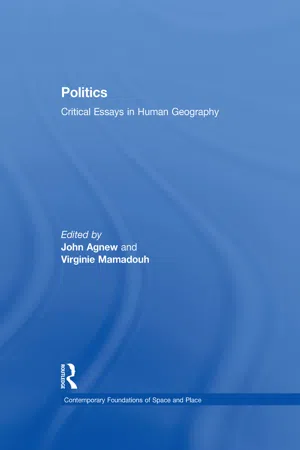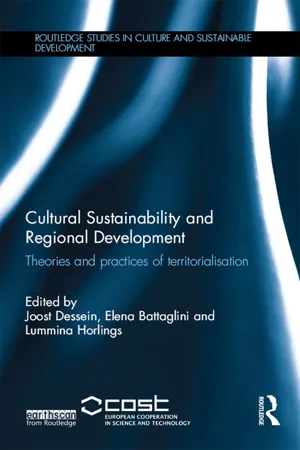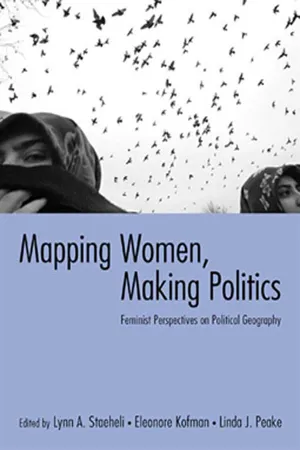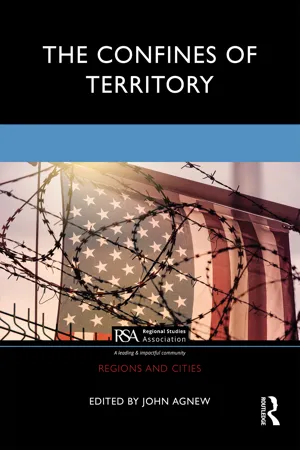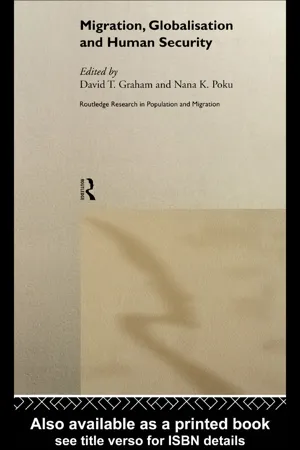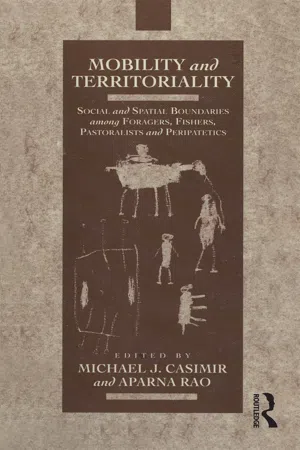Geography
Territoriality
Territoriality refers to the attachment of individuals or groups to a specific area or territory, often leading to the establishment of boundaries and the defense of those boundaries. It encompasses the physical, emotional, and symbolic connections people have with a particular space, influencing behaviors and interactions within that area. Territoriality plays a significant role in shaping human geography and the organization of space.
Written by Perlego with AI-assistance
Related key terms
Related key terms
1 of 4
Related key terms
1 of 3
10 Key excerpts on "Territoriality"
- eBook - ePub
Politics
Critical Essays in Human Geography
- Virginie Mamadouh, John Agnew(Authors)
- 2017(Publication Date)
- Routledge(Publisher)
Part I Agendas for Political GeographyPassage contains an image
[1]Human Territoriality: A Theory
Robert D. Sack Department of Geography, University of Wisconsin, Madison, Wl 53706Abstract. Territoriality is a means of affecting (enhancing or impeding) interaction and extends the particulars of action by contact. Territoriality is defined here as the attempt to affect, influence, or control actions, interactions, or access by asserting and attempting to enforce control over a specific geographic area. A theory of Territoriality is developed that contains ten potential consequences and fourteen primary combinations of consequences to territorial strategies. It is hypothesized that any instance of Territoriality will draw from among these. Specific consequences and combinations are predicted to occur in particular social-historical contexts.Keywords : Territoriality, spatial analysis, power, control, accessibility.HUMAN Territoriality is a vast, yet often neglected, facet of human behavior. I propose to analyze Territoriality by considering it to be a strategy for influence or control. I shall present a theory of the potential advantages that can come from the use of Territoriality.By human Territoriality I mean the attempt to affect, influence, or control actions and interactions (of people, things, and relationships) by asserting and attempting to enforce control over a geographic area (Sack 1981). This definition applies whether such attempts are made by individuals or by groups, and it applies at any scale from the room to the international arena. This is not the usual definition of the term and is intended to include many facets of behavior often referred to by other concepts such as property in land (real estate), sovereignty, dominion, “turf,” and “fixed personal space.”Like Dyson-Hudson and Alden-Smith (1978), I shall skirt the issue of whether human Territoriality is a biological drive or instinct. Rather, I see it as a strategy for establishing differential access to things and people. Interactions or access can occur either territorially or nonterritorially. Nonterritorial interactions have been the primary focus of systematic spatial analysis. Yet these occur in causal relationship to numerous kinds and levels of territories. To ignore Territoriality or simply to assume it as part of the context is to leave unexamined many of the forces molding human spatial organization. The area of geography that has most often sensed the significance of Territoriality is political geography, but with some exceptions (Soja 1971, 1974) political geography has not yielded a sustained and systematic analysis of its role and function. I intend to show how a theory of the potential consequences of Territoriality can help to make a spatial perspective of more direct use to the analysis of property, political sovereignty, and the territorial structure of organizations. - eBook - ePub
Cultural Sustainability and Regional Development
Theories and practices of territorialisation
- Joost Dessein, Elena Battaglini, Lummina Horlings(Authors)
- 2015(Publication Date)
- Routledge(Publisher)
Research on human Territoriality consolidated during the 1960s when social science scholars began to look at ethology with more interest. They realised that the vast knowledge about animal behaviour as related to space could yield promising results when applied to humans. In this scientific milieu, a whole research programme emerged and firmly positioned itself in the fields of sociology and psychology. Its premises could be summed up by a definition of Territoriality that revolved around demarcation (constructing and communicating territories through marking behaviours) and defence of space (maintaining and restoring territories). Territoriality was then conceived as ‘the act of laying claim to and defending a territory’ (Hall, 1959: 146). It involves ‘the mutually exclusive use of areas and objects by persons and groups’ (Altman, 1975: 106) by means of ‘repulsion through overt defense or some form of communication’ (Dyson-Hudson and Smith, 1978: 22). The scientific discourse on Territoriality has further been explored in the work of Sack (1986) and Brown (1987) and via classic reviews (Lyman and Scott, 1967; Altman, 1970).This way of investigating generated a large corpus of knowledge that has helped us understand our relationship with space; however, by emphasising the control of resources via the demarcation and defence of space, this approach ‘has distorted the picture of human territorial functioning by suggesting that territories become important only when they are violated or threatened’ (Brown, 1987: 173).Human Territoriality can be a vehicle for much more subtle processes than animal Territoriality, and we must go beyond this approach, imbued as it is with an outdated notion of either rationality or instinctiveness as the main avenues to the understanding of human behaviour. By breaking free from this ethological heritage, we will be able to appreciate how territories offer a great variety of opportunity for social organisation and we will come to a much broader understanding of how we relate to space and what kind of opportunities space affords us.What we do to space; what space does to usThe current discourse on human Territoriality also revolves around the much debated issue of the hegemony of nature versus culture; sometimes this dispute reaches the impasse of the unsolvable dilemma of the subject or object supremacy. The relationship between society and the environment is characterised by intense dialectics where neither society nor the environment prevails: space is simultaneously shaped by society, but is also capable of shaping society. The environment is continuously modified, planned and designed by society but, at the same time, the environment defines the conditions for social action and it thus helps to define society itself. This dialectic is expressed by the conceptual pair of ‘place-making’, i.e. the direction of the relationship where it is society that defines space (Prior, 1988; Baldry, 1999) and ‘emplacement’, i.e. the direction of the relationship where it is space that defines the possibility for social behaviour (Lefebvre, 1974) (see Figure 6.1 - eBook - ePub
- Robert Gutman(Author)
- 2017(Publication Date)
- Routledge(Publisher)
5 Territoriality: A Neglected Sociological Dimension Stanford M. Lyman and Marvin B. ScottTerritoriality, defined as the need of individuals and groups to claim some geographical area as their own, is another need of the human personality that can best be satisfied through the provision of specific environmental or spatial conditions. The specific environmental condition that can fulfill this need is the availability of a fixed, circumscribed area, which the individual or group has the capacity to control. A territory, because it is a fixed area, can be said to exist even when the individual identified with it is not physically present. Territory thus differs from personal space, which is something an individual carries around with him. (Personal space is sometimes referred to as portable territory.)Most discussions of the concept of Territoriality note that it was first developed to explain the spatial behavior of animals. As a consequence, the application of the concept to human behavior has usually proceeded by crude analogy, and thus people have tended to overlook the fact that concern for territory and the response to its invasion are linked to the symbolic and cultural dimensions of human psychology as well as to the biological. The great merit of the selection by Lyman and Scott is that it makes these connections clear. Territoriality is by definition a spatial phenomenon, but the way its boundaries are defined, the uses to which it is put, the manner in which groups cope with invasions, and the consequences of territorial deprivation for social order are all highly variable. The authors, for example, distinguish four different types of human territories (public territories, home territories, interactional territories, and body territories); three types of territorial encroachment (violation, invasion, and contamination); and three types of reaction to encroachment (turf defense, insulation, and linguistic collusion). - eBook - ePub
Mapping Women, Making Politics
Feminist Perspectives on Political Geography
- Lynn Staeheli, Eleonore Kofman, Linda Peake(Authors)
- 2013(Publication Date)
- Routledge(Publisher)
But what does it mean to say that territory is a social-political-cultural construction? We argue that territory and the bounding of territory reflect power relationships in that they are “produced under particular conditions and are designed to serve specific ends” (Storey 2001, 15). This way of understanding territory is useful not only for political entities such as states but also for economic entities such as multinational firms. Territory, though, also has a cultural component, which links identity and sense of place (e.g., contributions in Rokkan and Unwin 1983; Meinhof 2002). Sometimes the cultural sense of territory is expressed as a feeling of belonging as a result of positive experiences, but there may also be a feeling of nonbelonging that may arise from negative associations and practices of exclusion. All of these are gendered. To understand how,we must do some basic definitional work for several interrelated concepts.Territory is an area claimed by a single person or a group of people; it therefore is a concept that operates at a variety of scales, from the personal space of an individual to the space controlled by a street gang to the space claimed by a transnational corporation. The spaces are usually marked by boundaries ,1 which may be visible or symbolic and which may be more and less impervious to other claims on the same space. Functionally, the idea of territory works to provide a space for social action of various sorts and for various social actors. In providing such a space, territory is constructed through acts of inclusion and exclusion. Territoriality - eBook - ePub
- John Agnew, John Agnew(Authors)
- 2020(Publication Date)
- Routledge(Publisher)
For instance, it is no surprise to anyone who has studied patterns of land, and especially water, use in the Syro-Palestinian region, that the political parcelization of territory there is inimical to a sustainable human ecology for the region as a whole (Tal, 2002). Such a sustainable way of life will require cooperation (and power-sharing) among the different groups resident there. This shows that the study of land-use patterns, ecological sustainability and ecosystem resilience is more scientific than 'ethnogeographic', and that it is possible to reach determinate conclusions about land use, and correspondingly, territorial claims.What the various conceptions of Territoriality discussed above have in common is their failure to specify the value of particular territories - not just abstract space or contingent locations. This value ultimately involves showing that Territoriality is a necessary condition for the very existence of peoples. The reason is simply that all forms of human community require environmental goods and services provided by particular ecosystems for their maintenance and flourishing.In other words, territory is a crucial underpinning for the very existence of human life - and a theory of territorial rights must incorporate that into its justification. The initial way to do this is to establish a strong linkage between peoplehood and Territoriality and to specify a relation to territory that strengthens this linkage. Consequently, two elements are crucial in determining a right to territory: the connection between peoplehood and Territoriality in particular lands, and the difference between ecologically sound and unsound policies adopted by peoples in their territories. The first provides the scale at which territorial rights obtain; the second accords or fails to accord authority to the peoples (and their political institutions) in question.The connection between peoples and territories is conceptual, in the following sense. To conceive of a people, reference must be made to its territorial setting. Conversely, a territory is not simply geographical space, but the place - eBook - ePub
- David T. Graham, Nana K. Poku, David T. Graham, Nana K. Poku(Authors)
- 2005(Publication Date)
- Routledge(Publisher)
Constituencies need to be identified and located and the democratic implications considered seriously. Essentially, to be a good global citizen, or in Hegelian terms ‘a good state’, may involve rearranging the priorities that were once considered inviolable to political elites. Yet this may be achieved by stealth or subterfuge. The whole free-market trade arguments that have dominated international forums since GATT (General Agreement on Tariffs and Trade) are essentially about governing for a specific constituency under the banner of national reform. This is not to suggest some crude form of ‘capture theory’ or conspiracy theory but attests to a reality of global finance and the increasing influence capital interests are having on states and national policymaking outcomes. This aspect of globalisation has been well documented and there is no need to go over these debates (see Corbridge, Martin and Thrift 1994). But there is one aspect worth noting. In many respects the dichotomy between global capital and the state is a false one. McMichael and Myhre (1991) for example, claim that the current process of capital transnationalisation also involves a reorganisation of the state into a ‘transnational state’ commensurate with a shift in the regulatory regime from one that was ostensibly national in character to one firmly grounded in the global. Such thinking lies at the heart of the ‘end of geography’ thesis (see O’Brien 1992) concerning the loss of economic sovereignty and impinges directly upon our concerns about sovereignty in general. It is though, above all else, quintessentially about territory, but this too is becoming complicated.There is a prevailing set of spatial referents that resonate through our understanding such as space, place, milieu, region, environment, locality that are all used interchangeably with ‘territory’. Yet, despite the multiplicity of its usage, the meaning of Territoriality has remained disturbingly vague. It has become a trendy word which can mean anything from geopolitics of sovereign states to the idea that something is fixed by location. In a more exaggerated form, cultural critics like Baudrillard argue that territory is being remapped before our eyes and that we are rapidly becoming floating identities in a world characterised by hyperreality and ephemeral images. It is a world dominated by interconnecting media and multifaceted technology that is taking on a whole new vocabulary. Against such a backdrop where are our ideas about territory and its fundamental importance to our sense of attachment, to belonging, to sharing a collective identity that has a past, a culture—a set of images that stay etched in our subconscious? What becomes of our relationship to place as we have known it, to spatial communities, whether neighbourhood or small town, to the bonds of social capital and to those primordial social networks? Is the spatial/temporal phenomenon of postmodern capitalism actually destroying communities as we have experienced them? Has the technological juggernaut redefined space and our sense of relationship by creating a spatial anomaly whereby the actual sharing of space is a highly individualised process—a lonely vigil? These questions may resemble a script of a Star Trek - eBook - ePub
De Facto States and Land-for-Peace Agreements
Territory and Recognition at Odds?
- Eiki Berg, Shpend Kursani(Authors)
- 2021(Publication Date)
- Routledge(Publisher)
2 Territorial aspects of conflict settlements and the recognition conundrum
Incompatibility of ‘selves’ and territories
DOI: 10.4324/9781003041436-3Territoriality takes a central role not only as an important subject in the study of international relations and political geography but also in resolving ongoing conflicts as a matter of fact. We live in a highly territorialised world where the possession of and control over territory is an essential prerequisite of sovereign statehood (Ruggie 1993 ; Painter 2010 ). Territories serve as containers of sovereignty, and jurisdiction and governance have been understood as necessarily occurring within a bounded and controlled physical space (Gottmann 1975 ; Sack 1983 ; Johnston 1996 ). Perceived as exclusive properties, territories also contain a spatially informed political life surrounded by rigid borders (Vollaard 2009 ). Exclusiveness as such may also shift territory at the centre of an explanation of why violent ethnic conflicts are usually associated with the inability of rival groups to co-exist and share control over the same piece of land (Toft 2003 ).States still regard territories as vital to their security (Kocs 1995 ), even to the extent that ‘all other things being equal, more territory means more physical security from conquest or from coercion’ (Toft 2012 , 585). Regardless of the territory’s material value, states are fearful of disintegration and reject land losses at all cost. States are involved in the construction of boundaries that ‘give physical substance and symbolic meaning to notions of “us” and “them”, “ours” and “theirs” ’ (Penrose 2002 , 282). Delaney (2005 , 19) even concludes that clearly defined territory may ‘promote certainty and predictability, and therefore peace, security and order, and therefore efficiency and progress’. If control over ‘our’ territory means control over ‘their’ identity and this questions the minority group attachment to ethnic homeland, conflict becomes inevitable. It is not surprising to see that ethnic groups demand sovereignty over disputed territory, given that ‘they have both capability and legitimacy to do that’ (Toft 2003 , 12). Indeed, most struggles over land are at the same time legitimacy claims and, therefore, conflicts over territory may push states and entities to become more militarised and war-prone than conflicts without a history of territorial contestations (Weede 1976 ; Diehl and Goertz 1988 ; Gibler and Owsiak 2018 - eBook - ePub
Space Meets Status
Designing Workplace Performance
- Jacqueline Vischer(Author)
- 2007(Publication Date)
- Routledge(Publisher)
Planners and social theorists writing in the last century were almost unanimous in connecting the notion of home with a sense of belonging to the community. As early as 1948, a sociologist described neighborhood as a ‘territorial group, the members of which meet on common ground within their own area for primary social contacts’. 44 Many social theorists of the period assumed that if people were put in the same place and shared the same amenities, they would develop ‘locality consciousness’: they would form a community. The territorial contiguity argument asserts that geographical proximity is a powerful force for community development and social solidarity. In business today, the preferred term is ‘co-location’, and it is often invoked to counter traditional organizational (and geographical) silos. The counter-argument that sparked the debate questions whether physical environment alone can have such determining effects on behavior: sharing a place may not be a sufficient condition for the development of a sense of community, or team. The question emerging from the debate is the following: is Territoriality a social need that develops in an individual as a result of membership in a social group and of having a role in that social group? Or is Territoriality a basic need for ‘place’ that is expressed through social roles and behavior? As some companies have discovered, co-locating individuals and teams at work is not sufficient to ensure that they ‘jell’. The circumstances in which co-located workers become territorial are a function of social, cultural and management factors, as well as of their physical environment. Moreover, Territoriality is not uniquely a prerogative of the individual worker but is also a strong force in teamwork and group membership. It is this aspect of Territoriality that may be most useful to organizations, as work becomes more cooperative and project-based - eBook - ePub
The Firm and Territory
An Organizational Perspective
- Roberta Troisi(Author)
- 2022(Publication Date)
- Routledge(Publisher)
Territories consist of a series of economic and socio-cultural relations, including those with firms or an individual firm. This is a vision that places territories at the centre of the discussion and reconfigures the logical order of things. Territories can be repositioned as intelligent containers, or rather as accumulators of resources (Malmberg et al., 1996), in particular of knowledge, that provides a rich substratum of specific resources (Capello, 2009). Territories precede and do not exist because they are exclusively legitimated by networks, as they are the outcome of all the co-creations over time by means of the interaction between nature and human behaviour, the way resources are exploited, the way they manage tensions and conflicts, and the mode of coexistence. Territories are therefore a mechanism (Foucault, 2007), an explosive force (Lussault, 2007) and a product of human activity and of the culture of the human population that settles in a given territory (Painter, 2010). Territories consist not just of organizations but also of individuals and they develop thanks to complex relations taking place among the multiplicity of actors and the diversity of relations within their confines (Lundquist et al., 2014). By concentrating on the links between these elements and the territory, it is possible to interpret the territory as a network, as a connective tissue and relational space, that depends exclusively on the actions of the community living there (Simone et al., 2017). These actions consist of a variety of processes (natural, social, technical and economic) carried out by a wide range of actors. At the same time, each process contains the territory and, in turn, each process is contained in the territory - eBook - ePub
Mobility and Territoriality
Social and Spatial Boundaries among Foragers, Fishers, Pastoralists and Peripatetics
- Michael Casimir, Aparnu Rao(Authors)
- 2021(Publication Date)
- Routledge(Publisher)
land is not a clear referent. . . . In European societies . . . land is an area whose referent is an immutable grid written upon paper. . . . Tenure is some right or rights, partial or whole, to exclude others from the land represented on the grid.Ingold (1986: 130ff.) presented a theoretically broader view by stating that the difference between 'tenure' and 'Territoriality'corresponds to that between the social and material dimensions of human existence. . . . Tenure is an aspect of that system of relations which constitutes persons as productive agents and directs their purposes, Territoriality is an aspect of the means through which those purposes are put into effect under given environmental circumstances.When exclusive tenurial rights exist over '. . . bounded tracts of land' (Ingold 1986: 169), even a highly mobile form of animal husbandry, such as ranching, should, he feels, be treated as non-nomadic. Concerning the links between property, power and ideology in hunting and gathering societies, Barnard and Woodburn (1988: 10) wrote recently:We take the view that property rights are fundamental – that in these societies it is through rights to property and the ideologies linked with such rights that structures of equality and inequality are established and maintained. Rights in property, together with other socially recognized links between people and things, are vehicles for the expression of ideals and values and other manifest concerns about the nature of human beings and the way they relate and should relate to others.Many Australian groups described by Layton (1986), Morphy (1988) and Myers (1988) are examples of societies in which land as a human subsistence base is not very important; man and land are not seen as separate entities and social relations, ritual ties and the relationship with the sacred beings, which created land and people in Dreamtime, are all related to land. It is this web of relationships that creates a group-specific territory, within which '. . . land-ownership is not primarily an ecological institution but rather a political arena in which Pintupi organise relations of autonomy and shared identity' (Myers 1988: 65). Therefore Myers (1988: 53) is tempted to ask, whether '. . . land tenure is different from social relationships between (and among) people and other objects'.
Index pages curate the most relevant extracts from our library of academic textbooks. They’ve been created using an in-house natural language model (NLM), each adding context and meaning to key research topics.
Explore more topic indexes
Explore more topic indexes
1 of 6
Explore more topic indexes
1 of 4
